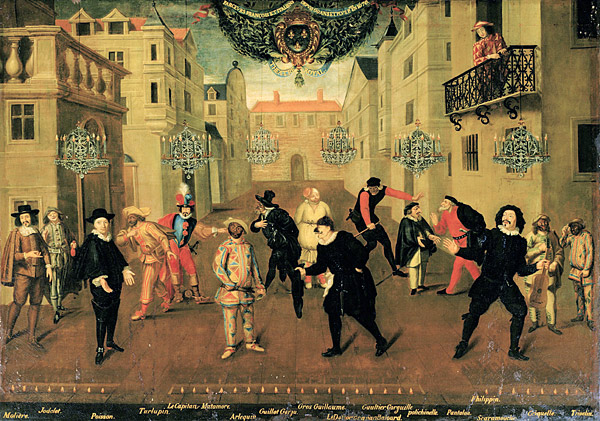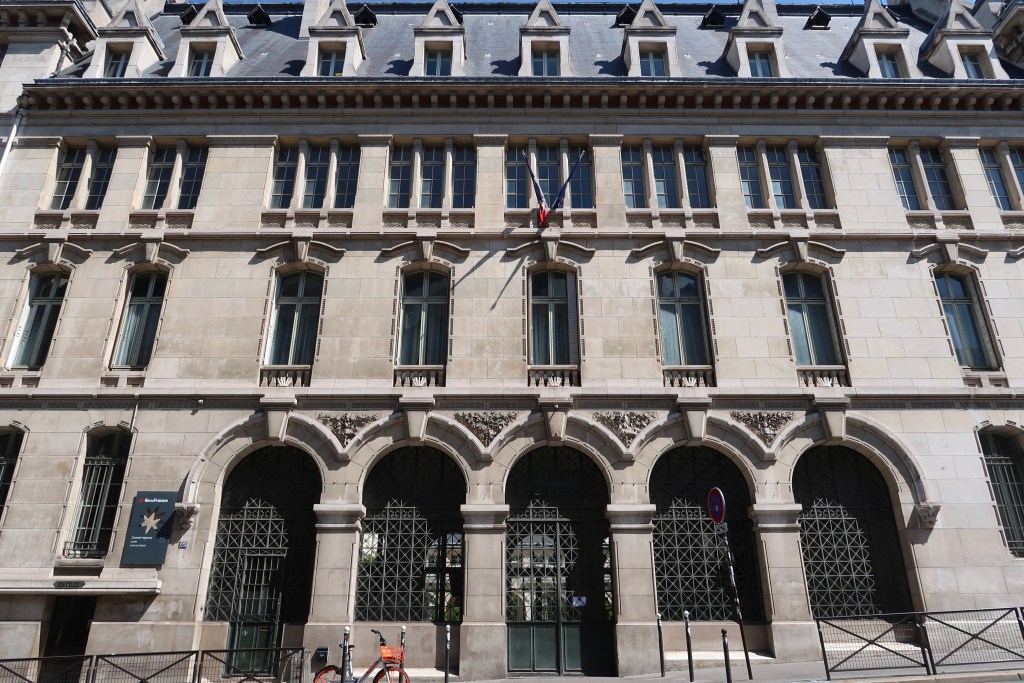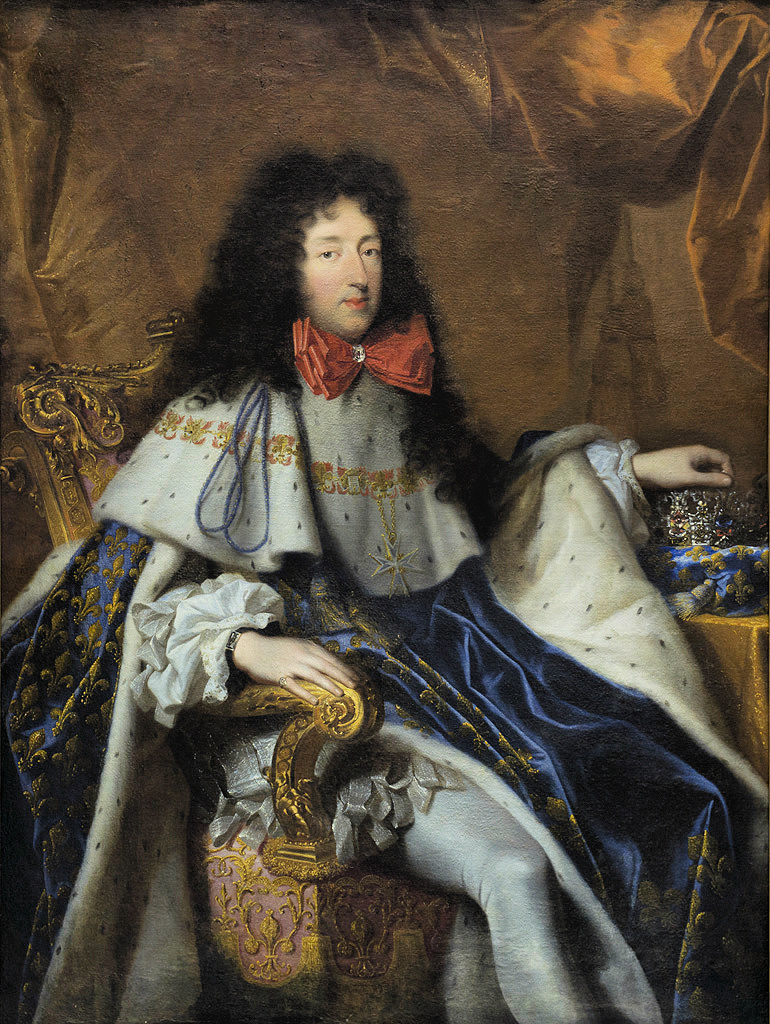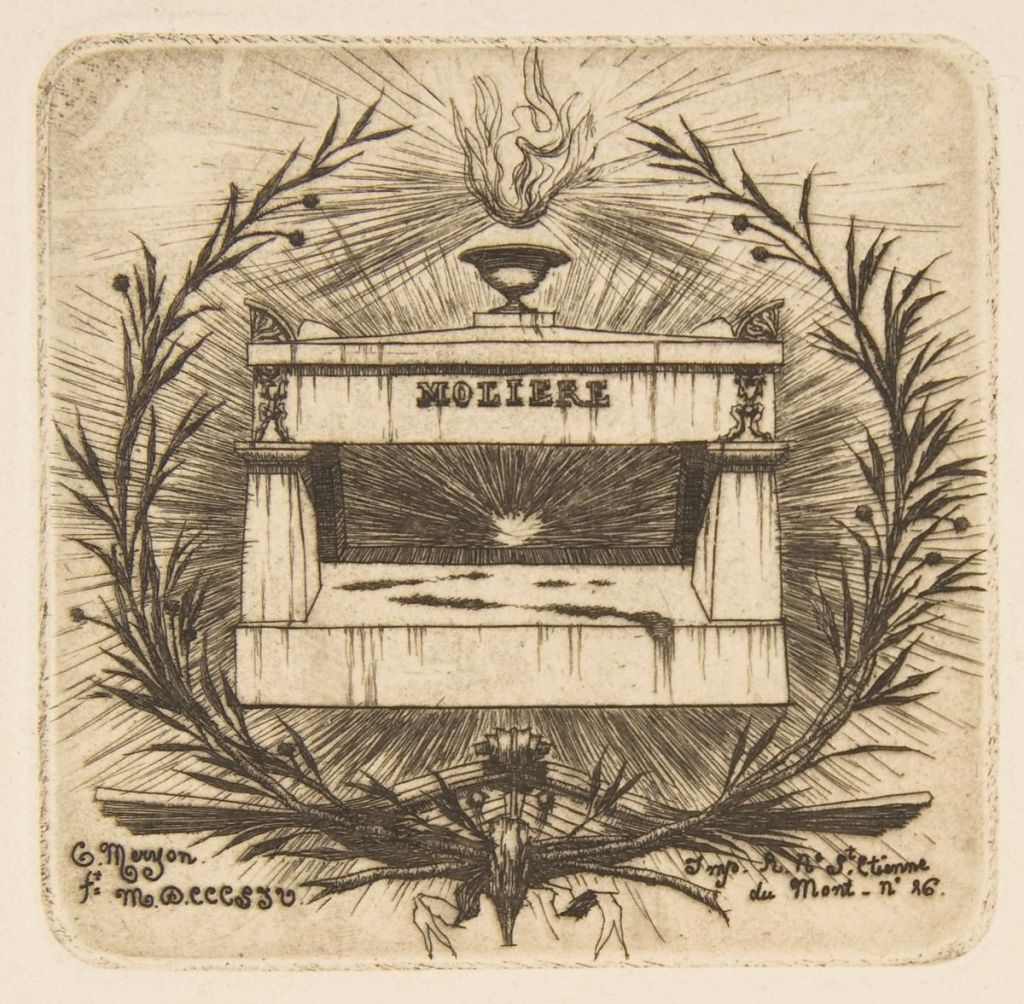
FEATURE image: Portrait of Molière, c. 1658 , Pierre Mignard (1612-1695), Château de Chantilly. Pierre Mignard is one of the major classic French portrait artists. When he crossed paths with Molière in Avignon in 1658, after having worked in Orange and Saint-Rémy, a great friendship started between the two men, until the death of the writer in 1673. The painting in Chantilly probably dates from this meeting, because the model appears to be less than forty years old.

Molière was born into a well-to-do family on January 15, 1622 at Rue St. Honoré and grew up near the Bastille at Rue Saint-Antoine in Paris. The greatest genius of the French theater was baptized at St. Eustache as Jean-Baptiste Poquelin. He adopted the stage name of Molière in the mid1640s after he founded his first theater troupe.

PHOTO credit: “Around St. Eustache Paris 1e (40)” by Julie70 Joyoflife is marked with CC BY-NC-SA 2.0.
A type of Shakespeare of France – profound theater actor, writer and poet – Molière’s characters and wit are timeless – such as in Tartuffe (1664), Don Juan (1665), and The Misanthrope (1666).
Romain Duris as Molière and Laura Morante as Elmire
French actor Romain Duris as Molière and Italian actress Laura Morante as Elmire in a scene from the 2007 movie “Molière.”
The fictional film is told in flashback to 1645. It is a conflation of two different periods in Molière’s life into one earlier period. Indeed, in 1645, 23-year-old bachelor Molière was bailed out of debtor’s prison. When his great, most controversial play, Tartuffe, appeared in the mid1660s, Molière was married and much older.
For the film, a presumably historical Molière poses as “Monsieur Tartuffe” (a priest) who serves as tutor for Orgon’s children. In real life, Molière played a part in his play, “Tartuffe,” but as the householder and trusting husband, Orgon. In the film, young Molière as Tartuffe, similar to the play, falls in love with Elmire, the neglected wife of the household.
In this scene Molière delivers a letter to Elmire from her secret admirer which, unknown to her, was written by the debonaire M. Tartuffe (Duris as young Molière).
Whereas in the present day any type of true romance may be heart-warming, the 17th century viewed romance through a lens of means and ends, either of which could be scandalous.
Molière’s great plays Don/m Juan and Tartuffe were halted in their tracks by French religious and royal authorities who were concerned that their characters and plots would provoke popular scandal. In the mid1660s, the Archbishop of Paris condemned Molière’s work – and nearly the libertine Molière himself – and then turned to the highest state authority, the king, with whom the top bishop was privileged to be closely aligned, to carry out the sentence.
“But I ought to warn you, strictly between the pair of us, that in Don Juan my master you see the greatest scoundrel that ever walked on Earth. He is a madman, a dog, a devil, a Turk. He is a heretic who believes in neither Heaven, nor saint, nor God, nor the bogeyman. He lives the life of an absolute brute beast. He is an Epicurean hog, a regular Sardanapalus who is deaf to every Christian remonstrance, and looks on all that we others believe as nothing but old wives’ tales. You say he has married your mistress. He would have done far more than that to gratify his desires. He would have married you, and her dog and cat as well. It costs him nothing to marry. That is the best baited trap he has.” – Sganarelle, servant of Don Juan, played by Molière. From Don Juan (1665).
“Oh, you scoundrel! At last I see you as you really are. But, unhappily, the knowledge comes too late; and it can only serve to drive me to desperation. But, be sure, your villainy will not remain unpunished. The Heaven you mock will avenge me for your faithlessness.“ – Donna Elvira, wife of Don Juan, played by Madmoiselle du Parc. From Don Juan (1665).
“Constancy is only fit for idiots.” – Don Juan, played by La Grange. From Don Juan (1665).
“You see him as a saint. … I see right through him. He’s a fraud.” – Dorine, played by Madeleine Béjart, Act 1, Scene 1. From Tartuffe (1664).
“It’s true – those whose private conduct is the worst,/Will mow each other down to be the first/To weave some tale of lust, and hearts broken/Out of a simple kiss that’s just a token/Between friends.” – Dorine, played by Madeleine Béjart, Act 1, Scene 1. From Tartuffe (1664).
“See, I revere/Everyone whose worship is sincere./Nothing is more noble or beautiful/Than fervor that is holy, not just dutiful.“ – Cléante, played by La Thorillière, Act I, Scene 4. From Tartuffe (1664).
“What good would it do to dissent? A father’s power is great.” – Mariane, played by Mlle de Brie, Act 2, Scene 3. From Tartuffe (1664).
“Don’t be deceived by hollow shows; / I’m far … from being what men suppose.“ – Tartuffe, played by Du Croisy, Act 3, Scene 6. From Tartuffe (1664).
“There’ll be no sins for which we must atone,/Because evil only exists when it’s known.” – Tartuffe, played by Du Croisy, Act 4, Scene 5. From Tartuffe (1664).
“Ah! Ah! You are a traitor and a liar!/Some holy man you are, to wreck my life, / Marry my daughter? Lust after my wife?” – Orgon, played by Molière, Act 4, Scene 7. From Tartuffe (1664).
“Damn all holy men! They’re filled with deceit!/I now renounce them all, down to the man.” – Orgon, played by Molière, Act 5, Scene 1. From Tartuffe (1664).
“All that we most revere, he uses/To cloak his plots and camouflage his ruses.” – Dorine, played by Madeleine Béjart, Act 5, Scene 7. From Tartuffe (1664).
For Molière, the Ancien Régime was not yet dead as a doornail. The American and French Revolutions were a distant century in the future. The latest risk in the late 20th and early 21st centuries of the Apostolic church selling its religion for parts in exchange for a share at the table of the new global faith was not yet a necessary strategy for a powerfully splendorous, yet ever troubled, church in 17th century France.
While “mixing it up” in politics may be the Catholic church’s normal path, it was the irreligious observations of its outcomes in human life in the 17th century that proved a major theme in Molière’s wittiest dramas and brought him into trouble. While the young King Louis XIV (1638-1715) approved orders that banned some of Molière’s farces, the royal personage expressed his reluctance to do so. It had been the priests who were stung by Molière’s popular ridicule with its social danger of being overthrown by comic truths. Their well-connected desires to cancel Molière proved only partly successful in the mid17th century–and, soon after that, hardly at all.

PHOTO credit: “King Louis XIV, 1638-1715 / Roi Louis XIV, 1638-1715” by BiblioArchives / LibraryArchives is marked with CC BY 2.0.
Writers of 17th Century French Literature
The 17th century continued the wealth of French literature in its many genres – poetry (Malherbe; La Fontaine; Boileau); novels and fairy tales (Cyrano de Bergerac; Perrault); essays (Pascal; La Rochefoucauld; La Bruyère); philosophy (Descartes); theology (St. Francis de Sales; Fénelon; Bossuet) and drama (Corneille; Racine; and Molière), and many others.
Molière’s Comedy – Wit And Types
Molière wrote based on actual facts of society and human nature and, using ludicrous incidents, looked straight ahead to a moral purpose – his plays were very instructive and had all the makings of high comedy. Further to attract us, Molière is the premier dramatist of wit.
His characters are not individuals but types – which allows for perhaps greater intensity than complexity. Though the French are not as known for comedy, the form is mostly indigenous, contrasted to tragedy as a dramatic form which came out of Italy.
The City of Paris Plays a Role
Paris is a theatrical city. Similar to today’s Beaubourg, there were outdoor performances at the Pont Neuf and Place Dauphine. The Hotel de Bourgogne on Rue Etienne Marcel was used in the 16th century by the Confraternité de la Passion for passion plays. In the mid1620s when America was a wilderness there would be street parades of comedians in Paris to lure spectators into the theatre. Stock farce characters included Aurlupin (mean spirited school teacher), Gros Guillaume (dressed in a flour sack), and Captain Fracasse (break things). At the permanent flea market of St. Germain de Prés, spectacles were put on stage. Goods were sold, some of it junk, because, as Daumier observed, “people are always fooled.”
Molière’s mother died when he was 10 years old and he was raised by a nurse maid. In his later plays there are often such maids and servant girls.

In Paris, three rival theatre groups coexisted: that of the Marais; that of the Hôtel de Bourgogne; and, that of the Palais-Royal, directed by Molière. After Molière’s death, the actors of the Marais joined Molière’s troupe of actors by royal order. This new troupe settles at the Hotel Guénégaud, rue Mazarine.


François de La Thorillière was Molière’s companion and kept the register of the company during the 1663/1664 and 1664/1665 seasons. He moved to the Hôtel de Bourgogne after Molière’s death. In 1680 La Thorillière, head of the troupe of the Hôtel de Bourgogne and the last rival in Paris of Molière’s former troupe, died. The King ordered these two troupes of French actors established in Paris to play together going forward.
On August 25, 1680, the actors of the Hotel de Bourgogne and that of the Hotel Guénégaud – Molière’s former troupe now led by La Grange – gave their first joint performance.
On October 21, 1680, an official royal letter signed at Versailles, established the unique troupe, composed of 27 actors and actresses chosen by the King for their excellence, to have a monopoly of performances in French so to “make performances of comedies more perfect.” The repertoire includes Corneille, Molière, Racine, Jean Rotrou, Paul Scarron, and others.
Molière Schools in Paris and Orléans
Molière was a commuter student at the Collège de Clermont behind the Sorbonne. Founded in the 1560s by the Jesuits who had a tremendous hold on educating the young in this period, it was renamed Lycée Louis-le-Grand in the 1680s. Nobility and the well-to-do bourgeois schooled together though segregated by a so-called “golden barrier” of identity – an illiberal, reactionary practice. Molière received a strict, excellent education and was a Latinist. He went to Orléans to study law but didn’t pursue it. His father sent him to Narbonne to be a royal tapestry maker (the family business) but Molière was idealistic and chose to be in theater. Following his bliss, twenty-something Molière – around the time of the film scene – was close to penniless for the next 15 years.
Following the queen of the sciences (theology), cultural authorities officially ordered the boycott of theater as immoral. But the people in Paris mostly ignored these bought-and-paid-for kill joys of church and state and the theater life thrived.

“File:Lycée Louis-le-Grand, Paris 5e 3.jpg” by Celette is marked with CC BY-SA 4.0.
Molière’s first theater production flops; bailed out of debtor’s prison by a street contractor
By the 17th century the Renaissance social fad of tennis had faded away and Molière rented empty courts for the theater. He joined Madeliene Béjart, four years older, and from a family of actors, and established his first theater in June 1643 called the Illustre Théâtre (“Illustrious Theater”). The first performances in the tennis court featuring the 22-year-old Molière and the others opened on January 1, 1644.

To build the theater, Molière fell into debt in 1644. The first performances were a complete flop and Molière was thrown into debtor’s prison for 3 days in July 1645.
There were two official theatre troupes in Paris in the mid 1640s– and Molière’s Illustre Théâtre was not one of them. The troupe did have a royal protector or sponsor, the king’s brother. But financial help was not to be had from Gaston d’Orléans (1608-1660). Rather, a paving contractor paid the bail to release the young actor/writer, a remarkable historical fact. Molière’s first theater was auctioned off with proceeds going to his creditors.

In 1646 Molière and Mme. Béjart joined a troupe led by Charles Dufresne (1611-1684). They relocated to the provinces, specifically to the west at Nantes and south. Success as an actor had been fleeting and Molière was very close to returning to his father’s business as a tapestry maker. Molière, like his fellow actors, could afford to wear only his street clothes on stage – or vice versa. Molière was part of just one theatre troupe among about 1,000 in France.
Others of the defunct Illustre Théâtre joined Molière in 1648. Dufresne handed over the direction of the troupe to Molière in 1650. He rechristened the troupe Comédiens de SAR le prince de Conti. The prince de Conti (1629-1666), fifth in line to the French throne, was Molière’s patron and friend. At the domaine de la Grange des Prés at Pézenas in Languedoc, the prince and the actor-playwright discussed plays and theater.


In the 1650s, Molière’s troupe became moderately successful performing all over the Mediterranean in France. Though Molière kept a notebook to record his ideas and character types these personal items have been lost to history.

The prince de Conti, Languedoc governor, was the king’s cousin, and, upon marrying Anne-Marie Martinozzi (1637-1672) in 1654, an in-law of sorts to Cardinal Mazarin (Anne-Marie was Mazarin’s niece). The prince di Conti, however, lived with his mistress at Pézenas among Molière’s free-spirited actors. In 1655 the prince, being engaged in military campaigns in Spain and experiencing failing health, had a religious awakening. He discarded the mistress, returned to his wife and banished the theatre. Molière was suddenly cancelled.
Allowance of theater in society based on moral grounds would continue to evolve – though audiences always enjoyed its entertainment value. Finding a need and filling it, Molière sold drama as morality (and vice versa) and using dialogue and plot that cut things close to the bone.

Armande Béjart was in Molière’s troupe in 1653 under the name of Mademoiselle Menou and played child roles. Married to Molière in 1662, she was the inspiration for all his heroines: the Princess of Élide, Charlotte, Célimène, Lucinde, Elmire, Alcmène, Élise, Angélique, Lucile, Hyacinthe, Henriette.
Armande and Molière’s daughter, Madeleine-Esprit, survived but their two sons did not. When Molière died in 1668, Armande encouraged the troupe, led by La Grange.
In 1677 Armande remarried a man not in the theater named Guérin d’Etriché and they had a son. She became Mademoiselle Guérin on stage in the troupe brought together by Louis XIV in 1680 and retired in 1694.
After being cancelled by the prince de Conti who became an implacable enemy of the theater until his death in 1666, the reputation of Molière’s traveling troupe was being critically appreciated at the highest levels. In 1658, the king’s brother, 18-year-old Philippe d’Orléans, le Monsieur (1640-1701), arranged an audition for Molière and his troupe in Paris. The result was that King Louis XIV approved the Troupe de Monsieur to share the royal theater, the Petit-Bourbon. Molière immediately premiered there on November 2, 1658. The troupe soon had to build up its cast and repertoire to meet the Paris audience’s expectations and Molière looked to provide them with original comedies. This was notably effected by the addition of 24-year-old La Grange, who would play young romantic lead roles, in 1659.
Also in 1659, having acquired the king’s favor, Molière set about to write the first of his great works: Précieuses Ridicules. In 1662 he married Madeleine Béjart’s younger sister (possibly daughter), Armande. The king was godfather to their child as Molière now performed at the Palais Royal for the king and royal family. In the next years, Molière wrote plays about marriage, jealousy, and adultery, including The Imaginary Cuckold in 1660; Don Garcie de Navarre and The School for Husbands in 1661; and, a great success, The School for Wives in 1662. Opening in December 1662, by the end of May 1663, audiences filled the theatre to watch The School for Wives, a play whose scheming plot is more straightforward than its characters, in over 60 performances. It was afterward attacked by critics who felt and feigned outrage for its sexual references and irreligiosity, but also, possibly, envy of its newness and blatant success. A flurry of artful broadsides between Molière and the King’s Actors at The Hôtel de Bourgogne followed in pamphlets and on their respective stages.
“People of quality know everything without ever having learned anything.” (Les gens de qualité savent tout sans avoir jamais rien appris.) – Mascarille, played by Molière, Act 1, Scene 8. From Précieuses Ridicules (1659).
“A man’s not simple to take a simple wife. Your wife, no doubt, is a wise, virtuous woman. But brightness, as a rule, is a bad omen. And I know men who’ve undergone much pain because they married girls with too much brain. I want no intellectual, if you please.” – Arnolphe, Act 1, Scene 1. From School For Wives (1662).
“It must be confessed that love is a skillful instructor. It teaches us to be what we never were before. By its lessons a complete change in our manners is often the work of a moment. It overcomes obstacles in our very nature, and its sudden effects seem like miracles. It makes misers liberal in an instant, cowards become heroes, and, dear gentlemen, it turns the most inexperienced mind into a nimble wit, as it gives understanding to the most simple.” – Horace, Act 3, Scene 4. From School For Wives (1662).


The middle 1660s was a high point for Molière’s plays: Tartuffe; Festin de Pierre (Don Juan) and Le Misanthrope were all written in these same two or three years (1664-1666). These greatest comedies of enduring genius, however, were not well received in their days by a mostly obliging audience yet who took governance and religion very seriously. In May 1664, Molière staged the first three acts of his later Tartuffe at Versailles. Called The Hypocrite, the play was immediately banned by Louis XIV. When it opened again in 1667 as The Imposter, it was once more immediately banned. Any further performance – and this extended to its audience – adventured excommunication. It was not until February 1669 that Louis XIV allowed the performance of Tartuffe in its completed five act form. It instantly became the hottest ticket in Paris.
A prosperous man wanting to retain his hard-earned social position and continue to practice his theory of the stage as the layman’s pulpit, Molière in these final years turned toward lighter, innocuous spectacles to teach and entertain French society. In 1665 Don Juan ran for 15 performances though it was censored and its financial proceeds had to benefit the Church.
“I expect you to be sincere and as an honourable man never to utter a single word that you don’t really mean.” – Alceste, played by Molière, Act 1, Scene 1. From The Misanthrope (1666).
“There’s a season for love and another for prudishness, and we may consciously choose the latter when the hey-day of our youth has passed—it may serve to conceal some of life’s disappointments.” – Célimène, played by Armande Béjart-Molière, Act 3, Scene 4. From The Misanthrope (1666).
“I’ll confront her in no uncertain terms with her villainy, confound her utterly, and then bring to you a heart entirely freed from her perfidious charms.” – Alceste, played by Molière, Act , Scene . From The Misanthrope (1666).
“The failings of human nature in this life give us opportunities for exercising our philosophy, which is the best use we can put our virtues to. If all men were righteous, all hearts true and frank and loyal, what purpose would most of our virtues serve?” – Philinte, played by La Grange, Act 5, Scene 1. From The Misanthrope (1666).
“You shall observe me push my weakness to its furthest limit and show how wrong it is to call any of us wise and demonstrate that there’s some touch of human frailty in every one of us.” – Alceste, played by Molière, Act 5, Scene 4. From The Misanthrope (1666).
At rest in Père Lachaise Cemetery in Paris since 1817, Molière was denied a Catholic burial in 1673
The baptized Molière died in 1673 at 51 years old. He was denied a religious burial for the simple fact that he was a theater actor. The traditional wing of the Catholic Church constantly impugned Molière’s work. Educated by the more liberal Jesuits, Molière never renounced his Catholicism, and was probably not an atheist. He was secretly buried in a Catholic cemetery in the section of unbaptized infants. In 1792, during the French Revolution, Molière’s remains were transferred to the museum of French Monuments. In 1817, Molière was laid to rest in Père Lachaise Cemetery where he lies today.

Molière’s legacy
Tartuffe disguises himself as a virtuous man and is a hypocrite. As the French celebrate Molière’s 400th birth anniversary they reflect on the relevance of Molière’s drama for today. Some argue that false faces in democracy are just as numerous as those in mid17th century Paris though perhaps in a different way.
Cancel Culture derives from Tartuffe
The cancel culture can be said to derive of Tartuffe. Though not displaying a purely religious hypocrisy as in Molière’s original character, today’s Tartuffe hates the individual heart’s freedoms and hides their will to crack down on people by citing the “common good” or other platitude which usually includes a spectrum of needs and fears. Notions of superiority, duplicity, and simple stupidity are present in Molière’s Tartuffe – that is, the hypocritical type of 350 years ago.
A supposed offense today is paired with Molière’s hypocrite of 350 years ago against a partisan viewpoint of the “higher interest” with its obligations and payments “overdue” to them from which as a penalty and means requires the ban, cancellation, and banishment –yet, almost conveniently, not of one’s fragile self, if opposed. While the perennial distrust of politicians is well known, today’s social breakdown is broader and endemic – with the inflation of hypocrisy a common denominator.
Like a popular play on an outdoor stage in 17th century Paris, hypocrites can be better recognized, fortunately or not, by type. The brittle use of virtue signaling can offer one such type. When it becomes evident that it serves the practicioner’s hidden ends, the audience, assuming its role, heckles and boos such stock farce characters off the stage with gusto.
Though censorship and restrictions of thought and action of others in its many forms is hardly always the result of hypocrisy, hypocrites (whichever side of the fence their belief or opinion may fall) are certain to take the short route to do so.
Molière would have sufficient material today to write and perform another of his great dramas for the 21st century and whose production is under a similar menace of cancellation by such powers grown antagonistic to his content and close or lower the curtain when opportunity is seen to enter.

FURTHER READING:
https://www.gradesaver.com/tartuffe/study-guide/quotes in MLA Format Osborne, Kristen. Cedars, S.R. ed. “Tartuffe Quotes and Analysis”. GradeSaver, 8 January 2013 Web.
https://www.britannica.com/biography/Moliere-French-dramatist#ref362537
https://www.comedie-francaise.fr/fr/la-troupe-a-travers-les-siecles
https://www.comedie-francaise.fr/fr/histoire-de-la-maison#
https://www.comedie-francaise.fr/fr/artiste/armande-bejart
https://www.sparknotes.com/drama/misanthrope/quotes/
Molière, Tartuffe and Other Plays, trans. Donald M. Frame, New York: Signet Classics, 2015.
Molière, The Misanthrope, trans. Henri van Laun (1876), New York: Dover Publications, Inc., 1992.
http://theatre-classique.fr/pages/pdf/MOLIERE_PRECIEUSESRIDICULES.pdf
George Saintsbury, A Short History French Literature, Oxford: Clarendon Press, 1901.





